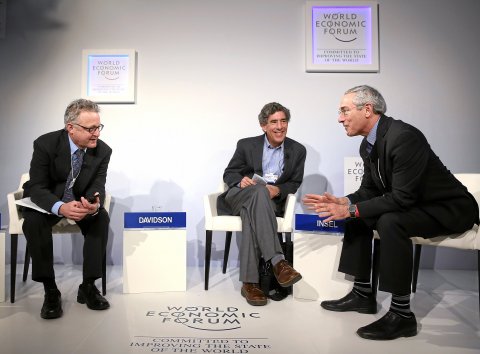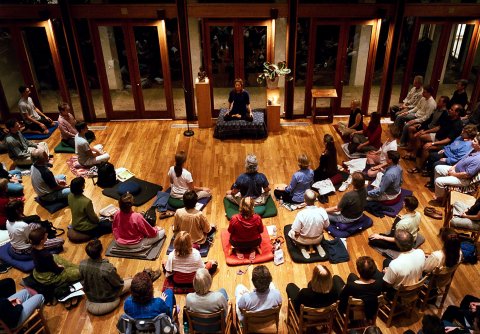It was 5:30 in the morning on my third day of silent meditation when I noticed something in me take a sharp turn left.
I was groggy, frustrated by my inability to sit still and hungry for the breakfast that was still an hour off. I got up from the spot on the floor of my bedroom where I'd been attempting to meditate and walked outside, to the new-growth woods behind the residential quarters at the Vipassana Meditation Center in Shelburne, Massachusetts. It was springtime, and the outdoors seemed spring-loaded with potential: The buds on the trees were sharp little things, and hundreds of fuzzy fiddleheads dotted the forest floor, curled snug.
I walked down a little looping path that stopped unsatisfyingly soon; "course boundary" signs curtailed my meandering to an area of the woods the size of a soccer field. Exercise, like so many things here, was not permitted.
For the past three days, a brass bell had woken me up at 4 a.m., along with the 129 others who had committed to this 10-day silent saga. We meditated, with guidance, for roughly 10 hours a day, broken up by meals and "free time," which was free only in the sense that we weren't meditating. We weren't allowed to read or write, speak to one another, make communicative gestures or even look at one another in the eye. So we all paced the small loop in the woods, staring at trees, careful not to acknowledge one another's existence. No nodding, no smiling.

During free time after lunch, I walked outside to find a cluster of women standing in the courtyard stock-still, eyes closed, faces tilted toward the sun, looking posed for alien abduction. One woman wore a Nirvana band T-shirt, presumably unironically. I began to giggle aloud, a major transgression, but I couldn't help it. It all seemed so ridiculous. What the hell was I doing here? There's no way, I thought, that this silent sitting around, this utter lack of mental stimulation, could be benefitting my brain. I briefly entertained the idea that this was all one massive 2,500-years-running placebo effect. I went over my last few days in my mind. I looked back at the cluster of women. Is this what it felt like to be brainwashed? Was I mid-brainwashing? Would someone being brainwashed question whether she was being brainwashed? No, I finally told myself, I wasn't being brainwashed; I was being silly. I turned away and stood outside in the sun for a while, in silence, and resigned myself to the idea of another week of this.
My Brain Is Soft Plastic
In the last few years, the human quest for self-optimization has collided with improving mobile technology to birth more than 100,000 health apps for smartphones. The mobile market research firm Research2Guidance estimates that mHealth apps, as they're called, will be a $26 billion industry by 2017.
Every waking (and sleeping) hour of your corporeal existence can now be quantified. Your data can be as granular as you like, and you can take it a step or two further: You can track your eating habits with a fork that vibrates when you're eating too quickly. Or put on a headband that will watch your brainwaves and play "loud, disruptive wind" noises if your mind wanders. Or strap on a device that will zap you when you aren't sitting up straight.
In theory, having more real-time data about our bodies means we can better mold them according to our will. But in practice, it may not be working out that way. Dr. Des Spence, a general practitioner in Glasgow, Scotland, argued in the British Medical Journal last year that constant self-tracking turns healthy people into "neurotics."
"The truth," he said, "is that these apps and devices are untested and unscientific, and they will open the door of uncertainty. Make no mistake: Diagnostic uncertainty ignites extreme anxiety in people."
Related: For a First Taste of Meditation, Just Start Paying Attention
Other popular iPhone apps claim to make you smarter. Brain-training games hinge on the belief that completing working memory "training tasks" can effectively teach the brain to function better in the real world. But research in the last few years has shredded that claim. Zachary Hambrick, a psychology professor at Michigan State University, worked with a team that published a paper in 2013 showing no evidence whatsoever that brain games improved intelligence. "The only solid result is that working memory training makes people better at the working memory training task itself," he says. And who cares about becoming an expert at practicing?
Take another step beyond consumer products and you'll find the burgeoning field of DIY biohacking. Transcranial direct-current stimulation is at the center of the movement. It involves strapping electrodes to one's head and running a low dose of electricity through the brain. The therapeutic potential appears enormous; early research into TDCS suggests it may prove useful for treating a range of mental health issues like depression and bipolar disorder, quitting smoking and easing chronic pain, among a multitude of other potential applications. For the DIY crowd, a central appeal is neuroenhancement—the potential to prompt clear-headed focus and amp up cognitive functions such as reading or learning a new skill.
But all these interventions are temporary and rely on devices and paid services. They are also relatively unproven. What if the ultimate neuroenhancing biohack is 2,500 years old, requires no equipment and costs nothing?
A few years ago, a computer scientist and a neuroscientist at the University of Arizona enrolled 45 human-resource managers in a trial: One-third of them took eight weeks of mindfulness-based meditation training, one-third took eight weeks of body relaxation training and one-third had no training at all. All three groups were given "stressful multitasking" tests before and after the eight-week period; those in the mindful-meditation group were able to sustain their focus longer than both other groups and reported feeling less stressed during the test.
The brain changes functionally and structurally all the time, taking in lessons from and responding to the stimulus of daily life. Neuroscientists call this neuroplasticity. But what if you could determine the way your brain changes? For years, Richard Davidson, a neuroscientist and founder of the Center for Investigating Healthy Minds, a research hub that studies the effect of meditation on the brain , has referred to the neurological effects of meditation as "rewiring the brain."

"Rewiring is not a scientific term, but it captures something truthful and important, I think, about what may be occurring," he says. "Neuroplasticity happens wittingly and unwittingly. And most of the time, it happens unwittingly. Most of the time, our brains are constantly being shaped by forces around us of which we are really not aware or dimly aware." But research suggests that meditators (he's one) are able to intentionally guide that process. "The research indicates...we can actually influence the functional and structural changes in our brain."
Research into mindfulness meditation has exploded in recent years. In 2014, 535 papers were published on the topic, according to the American Mindfulness Research Association. In 1980, there were just three. One study found that meditators appear to lose less gray matter over time than their non-meditating counterparts. Regular meditation, another study suggests, may "reduce the cognitive decline associated with normal aging."
One study, from 2012, found that long-term meditators may develop more gyrification, or "folding," of the cortex, which is associated with faster mental processing—and the more years a person meditates, the higher the degree of folding. Another study found evidence of increased thickness in the prefrontal cortex and right anterior insula, areas of the brain associated with attention and awareness of sensations and emotions in oneself and others.
Another found meditators who had practiced five years or more had "significantly larger volumes" of gray matter in the hippocampus, an area crucial to memory and learning. It's possible, the researchers wrote, that the differences constituted "practice-induced alterations" to how quickly the region generated new neurons. Regular meditation, in other words, might help you grow more brain.
The Addiction Fix
One technique seems especially promising. Vipassana is the Buddhist meditation technique on which the now wildly popular Westernized concept of "mindfulness" is based. The word Vipassana roughly translates from the ancient Pali language of Buddhist scriptures to "seeing things as they really are." Henepola Gunaratana, an influential Sri Lankan Buddhist monk, described Vipassana once as "looking into something with clarity and precision, seeing each component as distinct and separate, and piercing all the way through so as to perceive the most fundamental reality of that thing."
More than anything else, Vipassana meditation is about training the brain to quiet down—to not react on impulse alone. You might think you're not impulsive, but the next time a fly lands on your neck, watch how fast you swat it—probably before your mind has had a chance to notice the bug's existence at all. I have a similar hair-trigger response to a Gchat chime.
These sorts of knee-jerk reactions extend into the emotional realm. When something negative happens, or whenever we crave something, be it a cigarette or the approval of a peer, we react without thinking. And that creates habit patterns that ensure the mind will react in exactly the same way the next time a similar scenario arises.
Here's where meditation begins to show itself as a biohacking marvel. Learning how to interrupt one's reaction pattern—and then doing that over and over—can reshape behavior. And if behavior is changing, "then the brain is changing," says Katie Witkiewitz, a clinical psychology researcher and associate professor at the University of New Mexico. As a Ph.D. student at the University of Washington, she'd been part of a team led by Alan Marlatt and Sarah Bowen studying the potential for Vipassana meditation to cure addiction. The first trial took place in 2001, with low-security prisoners in a rehabilitation center in Seattle. The medical director, Lucia Meijer, had been on a Vipassana course and wanted to see whether what worked for her could also help her patients. She turned a building into a retreat center and invited Witkiewitz's team to study the outcome.

"It was amazing," Witkiewitz recalls. Six months after release, the formerly incarcerated people who had participated in a 10-day meditation course had higher rates of recovery than those who were enrolled in standard rehab treatment. Their mental health was also improving more than that of peers who didn't go through the meditation classes. It wasn't a randomized study, but the results were enough to prompt more research.
Three randomized medical trials followed in which people suffering from various addictions enrolled in mindfulness-based stress reduction (MBSR) programs, modeled on a secularized version of Vipassana (no stories about the life of the Buddha). The results were great. Meditation led to "significant reductions in drug use, significant reductions in heavy drinking, significant improvement in mental health, significant reductions in cravings," says Witkiewitz.
The crux of MBSR is learning to pause when one ordinarily wouldn't, observe what's happening in one's body and then move forward. "It's something we're calling the 'sober breathing space,'" says Witkiewitz. "So many people with addictions are reaching, reaching, reaching for the next way to get high or the next way to avoid what they're thinking." The meditation gives them a method to pay attention to whatever emotions they are experiencing—even if they are negative ones like shame and self-hatred—and to tolerate them until they pass. "What we're seeing happening is that for individuals whose brains have just been wired to be on autopilot from years of addiction, the ability to take a moment and pause—it's potentially almost like rewiring the addicted brain."
Sounds Like Christina Aguilera
I found out about Vipassana in the winter of 2014, in the midst of a breakup of the sort that upends every part of one's life. I was hungry for anything that might stabilize me when a cousin came back from a Vipassana retreat exuding an enviable sense of calm. She listened quietly as I babbled over brunch about the minutiae of my relationship drama and ticked off all the ways I needed to radically change my life. She said the retreat taught her to "be OK with what's going on now." I shriveled a little. Was my distress that obvious?
I had never meditated before, but I signed up for the waitlist. The retreat, like all Vipassana programs, was free, funded by donations from and run by a rotating cast of former students. While I waited, I watched "mindful living"—based on Vipassana traditions—have its media moment. Trend piece after trend piece chronicled the rise of meditation apps and Silicon Valley startup offices incorporating mindfulness meditation. A woman in Los Angeles even got a write-up in The New York Times for opening a "drybar for meditation." Six months after enrolling, I got an email notifying me I was off the waitlist.
By the third morning of meditating, my mind was still flailing wildly, jumping from one thought to the next to avoid being quieted. I felt as though I were being dragged around by a petulant child. The more I desired a quiet mind, the more wildly flamboyant my distractions became. As soon as I'd managed to banish the choruses of the last five songs I'd played on Spotify before the retreat began, up came a few bars from Christina Aguilera's Spanish-language rendition of "Come on Over." I'd memorized the song in a high school Spanish class years ago, and though today my mind could call up only half the chorus and one verse, it did so with vigor, repeating the bars ad infinitum, along with a montage of banal but absurdly detailed teen memories. The posters on the wall of that Spanish class. The serving containers in the cafeteria.
Then my thoughts turned abstract. With eyes still closed, I focused on the dark outline of my eye sockets on the inside of my eyelids, thinking that would tamp down the images. Bad move. Within moments, swirls of blue and yellow gyrated around the vague form of two ovals. I was distressed but kind of impressed; resisting quietude with a psychedelic light show is downright slick, really.
As calmly as I could, I pushed the light show aside too. At this point, I was regarding my galloping thoughts with detached amusement. There they were, charging around, without me. What a ridiculous spectacle. Slowly, the frenetic clamor dimmed. And after that, the meditation got easier.
The World, Unimaginable
Two days later, I walked outside. My morning meditation had gone relatively well, I thought, and I felt calm and concerned only with what was happening in the present. I saw a bird's nest cradled in a crook of the large, leafless bush about my height a few yards from the door. As I leaned in to peer into the nest, the bare branches filled my field of vision. A second passed as my eyes adjusted to the sunlight and focused on the empty bowl of the nest. As soon as they did, dozens of fat black ants came into focus too, scuttling up and down the branches in every corner of my field of vision. I was watching the ants without shifting my gaze from the bird's nest. The whole scene, peripheral vision included, was unnervingly crisp. It was like watching a scene in Imax, every corner in laser focus.
For the remainder of the retreat, walking in the woods was a sensory field day. I could see the fuzz on the slowly unfurling fiddleheads from yards away. For the first time in my life, I heard the dead leaves on the forest floor settling on one another. It sounded exactly like rain falling on trees. One afternoon, I watched a nuthatch land on a tree trunk. Its gray-brown body wasn't bigger than a child's fist, but I could hear its talons make contact with the bark. It sounded like a puppy's nails skittering on a hardwood floor. Nearby, water not more than an inch deep moved languidly along a ditch. I could hear that too.

Others who have been on a Vipassana retreat tell similar stories about sensory explosions. "Everything was just more vibrant," Witkiewitz says. "Foods tasted better."
"I use reading glasses," Davidson says. "[During retreats] I noticed that I was able to read things that I otherwise would have required glasses to read, without glasses. The effects didn't persist, but they were definitely present."
When I got home, New York City was briefly unmanageable. I felt daunted by the task of conversation, and socializing was unappealing. But within a few days, I'd readjusted to the speaking world, and I started noticing little, perhaps permanent, changes. There's a man who lives in my building whose every move carries such a strong air of entitlement that it's palpable when we share the elevator. Sometimes, during these rides, he'll make some remark about my appearance that leaves me steaming; after the retreat, I realized I didn't have to give a shit. When I faced my morning subway commute, I was less filled with the sense of existential malaise that used to come when I swarmed up the L train platform stairs wedged between two separate sets of shoulders, my forehead plunking lightly against the backpack of the person ahead of me over and over like a metronome. Now it didn't seem so bad. All these people were just trying to get to work too.
My impulse to fill pauses in conversations was toned down, and time slowed down a bit too, because I was paying more attention to things as they happened. My typical obsessive interest in thinking about what the hell I was going to do with the rest of my life also seemed reduced, along with my equally large drive to rehash recent social interactions and pick them apart for errors on my end. Perhaps biggest of all, the animosity toward my ex evaporated.
I decided to test out whether what I was feeling would translate to a real-life interaction, so I arranged for us to get coffee a week later; the first meeting since our telenovela-style split. As we chatted, I prodded myself mentally, searching for the familiar hurt and ill will. It wasn't there. Learning to let go of negativity sounds Hallmark-level trite, but there it was.
There's more. Before the retreat, Mathias Basner, an assistant professor at the University of Pennsylvania Perelman School of Medicine who studies sleep and biological rhythms, suggested I get my thyroid and cortisol levels tested before and after the retreat. Since both can be tied to stress, he hypothesized they might shift in a setting designed to train calmness. So I went to my doctor for blood work. Somewhat conveniently, for the purposes of my little experiment, my levels for both of those hormones were out of whack. A week before I left for the retreat, my thyroid levels were slightly abnormal, and my levels of cortisol, more popularly known as the "stress hormone," were four points above the upper threshold for normal, "double what I'd like to see for you," my doctor said.
Two days after the retreat ended, I went back to the doctor's office. My thyroid levels had dropped one full point. According to my doctor, it would take "at least six weeks" on thyroid medication to get that result. And my cortisol level fell almost 10 points, squarely within the normal range. That would ordinarily "take months" on a stress-reducing supplement, the doctor told me. He sounded impressed.
At the retreat, the teacher warned over and over not to look for major shifts in our lives when we got home. Any small changes—food that tastes a little better, the family interaction that seems a little less excruciating—are remarkable enough. But that constellation of little changes seemed just evidence, really, of a realization at once quotidian and grand: that with continuous effort, I could change the way my mind worked. The sense of control over my brain and, by extension, the ways I approach the world hit me hard the moment I first learned to temporarily shut up the part of my mind that frothed over with pop songs. I could decouple, however briefly, my sense of self from the meat sack of my mind and body. And that decoupling gave me the ability to actually control where that meat sack was headed next.





















